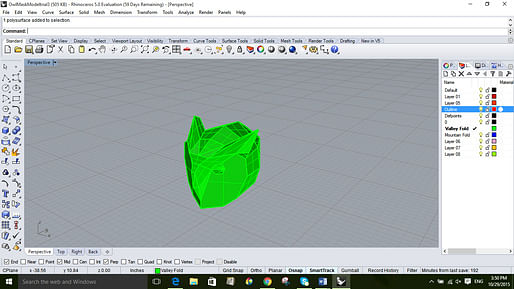

Last Halloween I was introduced to Wintercroft Masks; low-poly masks made from recycled paper products created by designer Steve Wintercroft. His designs are abstractions of animals, human faces, mythical creatures and others which are turned into geometric disguises. Designs are purchased in the form of templates and instructions by the designer allowing buyers to build their own rather than purchasing a pre-built mask. The masks are flexible enough that they can be customized and made from a variety of materials. After building one, I wondered how it would fare as an academic exercise.
Currently, I am teaching a small group of graduate students who have chosen to pursue a career in architecture and come from a variety of different backgrounds. My course focuses on visual communication through a series of design thinking exercises. The Wintercroft mask was a perfect challenge for them, as it allowed them to explore the complexity of the mask with Rhino software while helping develop their model making / crafting skills.

Each student purchased their own design and were asked to quickly assemble a mask which was reviewed for construction. Using chipboard allowed them to have a tangible mock up and could see firsthand how the geometries met, where the structure needed to be supported properly, and how the technique of folding paper can create space and form. After the analysis they were asked to re-create their mask in a 3D model, using only the instructions the designer had provided and their own recently built model. Because of the limited information, they had to decipher their way around the form of the mask, judging planes based off angles and length while experimenting with the vast amount of commands that Rhino can provide. Another caveat was added: the digital mask was to be constructed in the computer the same way as in real life, and therefore could not be “sculpted” but rather treated as one large unfolded surface.

Conveniently timed around Halloween, the project was completed this week. In the end, the students were asked to make one more wearable mask (their first mockup was red lined for mistakes and taken apart for analytical purposes) where they could add color and texture. Finally, the digital models were shrunk in the software and digitally printed. If done correctly, the 3-D print would come out just fine. So far, we have one test print with others coming shortly. 

This blog gives a sneak peak into the architecture world at the University of Miami. What began as an experiment following one group of incoming graduate students through their first semester of design, has morphed into a window of the school of architecture through this professor's eyes. I will try to post as often as possible.
No Comments
Block this user
Are you sure you want to block this user and hide all related comments throughout the site?
Archinect
This is your first comment on Archinect. Your comment will be visible once approved.